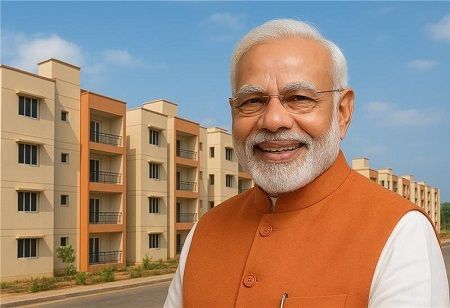
Since coming to power in 2014, Prime Minister Narendra Modi has made housing a cornerstone of India’s development strategy.
His government’s approach has gone beyond just constructing homes — it aims to create trust, transparency, and inclusivity in the real estate ecosystem. Through flagship schemes like Pradhan Mantri Awas Yojana (PMAY), reforms like RERA, and the Housing for All mission, the government has sought to make homes more accessible, affordable, and reliable for millions.
Let us take a look at some of the Key Impacts of PM Modi on India’s Housing Sector.
The impact of Pradhan Mantri Awas Yojana on rural housing has been transformative. Under PMAY-Gramin, the target was set at 2.95 crore houses, with crores already sanctioned and many completed. PMAY Urban vs Rural performance comparison 2025 shows that while urban centers have seen rapid construction, rural regions have benefitted from improved quality and speed of housing delivery.
A major highlight is the focus on women beneficiaries of PMAY housing scheme — many houses are registered in the name of women or jointly owned. This step empowers women, strengthens financial inclusion, and secures intergenerational stability. State-wise PMAY completion statistics India reveal strong performance in states like Uttar Pradesh, Gujarat, Andhra Pradesh, and Tamil Nadu, where housing for all mission progress report 2025 shows high occupancy rates.
The Real Estate (Regulation and Development) Act, 2016 (RERA) is one of the most significant reforms under PM Modi. It has created RERA success stories under Modi government, with buyers recovering delayed payments, stalled projects resuming, and legal recourse becoming easier. RERA mandates project disclosures, strict registration, and time-bound possession — which boosts buyer confidence and transparency in the market.
Declaring affordable housing as infrastructure has unlocked better financing terms, tax benefits, and central subsidies. This has made home loans cheaper and attracted private investment. The move supports affordable housing policy initiatives under Modi and helps economically weaker sections and low-income groups access dignified homes.
This policy has also contributed to job creation through housing sector under PM Modi, benefitting construction workers, suppliers, and allied industries. Urban slum dwellers have been rehabilitated, leading to success rate of slum rehabilitation under PMAY improving steadily in many states.
The Modi government has invested in technology use in PMAY monitoring and implementation by deploying geo-tagging, real-time dashboards, and micro-monitoring tools. These digital innovations enable grievance redressal and help states meet their targets efficiently. This emphasis on transparency ensures that funds are used effectively and houses are delivered on time.
Despite strong progress, challenges in PM Modi’s housing for all scheme remain. Some projects face execution delays, unfinished units, and rising material costs. Affordability in metro areas is still a hurdle, and regulatory enforcement can lag in remote regions. Aligning delivery timelines and securing continuous financing will be crucial in the coming years.
Also Read: PM Modi leads the Launch of key Housing Development Projects in Delhi
The role of housing sector in India’s GDP growth under Modi has been significant, with housing driving construction, employment, and consumption. PM Modi’s leadership has turned housing from a neglected sector into a key pillar of national development. His government’s initiatives — from PMAY to RERA to affordable housing as infrastructure — have transformed both policy and execution.
Going forward, the future of housing policy in Modi 3.0 government will depend on how well central and state governments synchronize efforts, sustain financing, and push innovation. The promise of “Housing for All” remains ambitious, but the momentum created over the past decade shows that it is no longer just a vision — it is an achievable reality.
We use cookies to ensure you get the best experience on our website. Read more...
Copyright © 2026 HomesIndiaMagazine. All Rights Reserved.